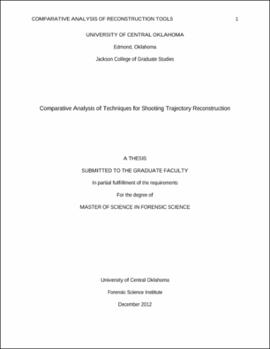| dc.contributor.advisor | McCoy, Mark R. | |
| dc.contributor.author | Finkle, Kiersten | |
| dc.date.accessioned | 2020-05-26T20:40:31Z | |
| dc.date.available | 2020-05-26T20:40:31Z | |
| dc.date.issued | 2012 | |
| dc.identifier.other | (AlmaMMSId)9979369585202196 | |
| dc.identifier.uri | https://hdl.handle.net/11244/324747 | |
| dc.description.abstract | Shooting trajectory reconstruction is a common discipline in the field of crime scene reconstruction. This discipline, however, has minimal published history about the origin, the most valuable techniques and methods, or journal articles. In addition, this type of reconstruction is used on a daily basis by law enforcement, but there is no validation of its procedures or tools. This study advanced the knowledge of the discipline of shooting trajectory reconstruction by applying geometric principles and modern day crime scene reconstruction techniques to help with the history of the discipline. Through the use of comparative analysis, this project determined beneficial and hindering aspects of modern tools. This was accomplished by analyzing three shooting scene reconstruction tools; specifically use of the Smart Tool, angle finder, and manual calculations utilizing a digital caliper to determine the efficiency of each technique. This project examined data taken by participants and determined the accuracy, precision, and error rate for the three tools. The study provided law enforcement with research enabling them to choose the most effective tool for crime scene analysis based on the tools tested in this project. This research also began the process validating the discipline of shooting trajectory reconstruction. A statistically significant difference in accuracy (mean bias) and precision (standard deviation) was found between the three tools. The difference between the accuracy and precision for the Smart Tool and angle finder was not statistically significant, however, the difference between those two tools and the digital caliper was significant. This difference between tools means that they cannot be averaged together when calculating results from a crime scene. No statistically significant difference in accuracy or precision was found between examiners and students, independent of the tools. Results indicate the angle finder was the most efficient tool tested. There was a statistically significant interaction found between the impact angles tested in this project. This interaction makes an overall error rate for the tools or discipline impossible.--Abstract. | |
| dc.rights | All rights reserved by the author, who has granted UCO Chambers Library the non-exclusive right to share this material in its online repositories. Contact UCO Chambers Library's Digital Initiatives Working Group at diwg@uco.edu for the permission policy on the use, reproduction or distribution of this material. | |
| dc.subject.lcsh | Forensic ballistics | |
| dc.subject.lcsh | Forensic sciences | |
| dc.title | Comparative analysis of techniques for shooting trajectory reconstruction. | |
| dc.type | Academic theses | |
| dc.contributor.committeeMember | Christophe, Deion | |
| dc.contributor.committeeMember | Jourdan, Thomas | |
| dc.contributor.committeeMember | O'Brien, Christopher | |
| dc.thesis.degree | M.S., Forensic Science | |
| dc.identifier.oclc | (OCoLC)ocn857857878 | |
| uco.group | UCO - Graduate Works and Theses::UCO - Theses | |
| thesis.degree.grantor | Jackson College of Graduate Studies | |
